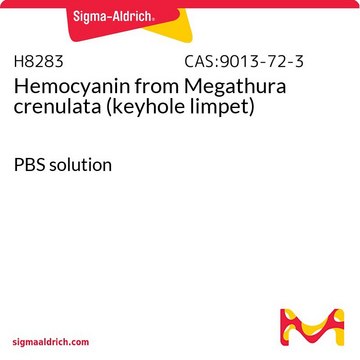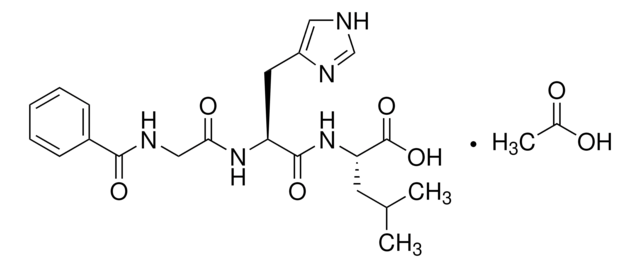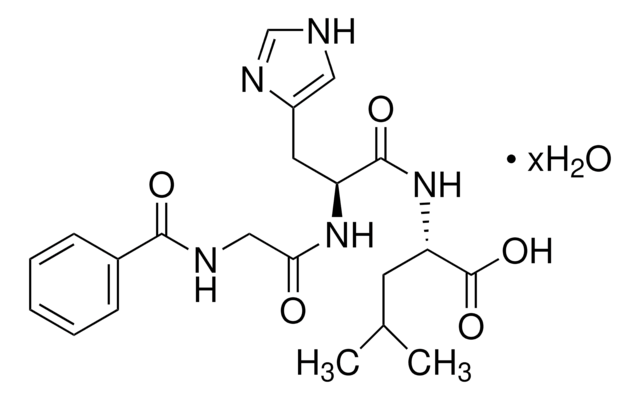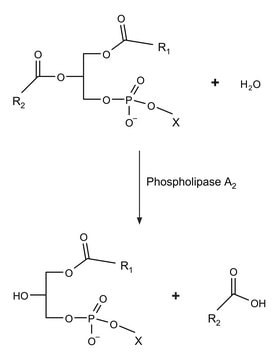Wszystkie zdjęcia(1)
Kluczowe dokumenty
H7017
Hemocyanin from Megathura crenulata (keyhole limpet)
Synonim(y):
KLH, Keyhole limpet hemocyanin
Zaloguj sięWyświetlanie cen organizacyjnych i kontraktowych
About This Item
Polecane produkty
pochodzenie biologiczne
Megathura crenulata
Poziom jakości
Formularz
powder
opakowanie
vial of KLH (KLH is present by weight at approximately 1 part KLH to 5 parts total solid.)
metody
ELISA: suitable
rozpuszczalność
H2O: soluble
temp. przechowywania
2-8°C
Szukasz podobnych produktów? Odwiedź Przewodnik dotyczący porównywania produktów
Opis ogólny
Gastropod hemocyanins are massive glycoproteins (4 to 8 MDa) designed by an intricate arrangement of 10 subunits that are self-assembled into hollow cylinders 35 nm in diameter.
Hemocyanin is a high molecular weight copper containing glycoprotein. It reversibly binds oxygen and forms the extra-cellular respiratory protein of mollusks. Keyhole limpet hemocyanin (KLH) is filtered from the hemolymph of Megathura crenulata, also called the giant keyhole limpet. It is native to the southern California coast and Mexico.
Zastosowanie
Keyhole limpet hemocyanin (KLH) is a strong and well known immune-stimulant in both experimental animals and humans. It has been used as a hapten carrier protein to enhance antigen-specific T cell priming and is known to stimulate a CD4+ T-cell response. Hemocyanins stimulate Th1 reactions without known side effects, which make them ideal for long-term continuous treatment of cancer.
Postać fizyczna
Lyophilized with stabilizing buffer
Rekonstytucja
Reconstitute with deionized water to a KLH concentration of 10 mg/mL, to yield an opalescent solution in 31 mM sodium phosphate buffer, pH 7.4, containing 0.46 M NaCl, 2% PVP and 41 mM sucrose.
Reconstituted protein solution may be stored up to 2 months at −20 °C.
Reconstituted protein solution may be stored up to 2 months at −20 °C.
Ta strona może zawierać tekst przetłumaczony maszynowo.
Kod klasy składowania
10 - Combustible liquids
Klasa zagrożenia wodnego (WGK)
WGK 3
Temperatura zapłonu (°F)
Not applicable
Temperatura zapłonu (°C)
Not applicable
Środki ochrony indywidualnej
Eyeshields, Gloves, type N95 (US)
Wybierz jedną z najnowszych wersji:
Masz już ten produkt?
Dokumenty związane z niedawno zakupionymi produktami zostały zamieszczone w Bibliotece dokumentów.
J T Brisbin et al.
Poultry science, 87(10), 1995-1999 (2008-09-24)
Subtherapeutic and prophylactic doses of virginiamycin are capable of altering the intestinal microbiota as well as increasing several growth parameters in chickens. In spite of the fact that the microbiota plays a role in shaping the host's immune system, little
Xiujuan Zhou et al.
Fish & shellfish immunology, 93, 641-651 (2019-07-26)
Interleukin-2 receptor subunit beta of flounder (Paralichthys olivace, fIL-2Rβ) was annotated on the NCBI, its gene was cloned and characterized functionally in this study. And then the amino acids sequences and tertiary structure of fIL-2Rβ were analyzed, respectively. RT-PCR and
Robert J Huber et al.
Histochemistry and cell biology, 136(2), 177-189 (2011-07-19)
The Dictyostelium discoideum homolog of mammalian cyclin dependent kinase 5 (Cdk5) has previously been shown to be required for optimal growth and differentiation in this model organism, however, the subcellular localization of the protein has not previously been studied. In
L R Ferguson et al.
Mutation research, 158(1-2), 89-95 (1985-10-01)
The tannins, delphinidin and procyanidin were isolated from flowers of white clover (Trifolium repens) and the leaves of Arnot Bristly Locust (Robina fertilis) respectively, and tested for mutagenic properties in a range of systems. There was no evidence for either
Tingting Chen et al.
Cancer biology & medicine, 17(1), 132-141 (2020-04-17)
Objective: Cancer stem cell is one of the important causes of tumorigenesis as well as a drug target in the treatment of malignant tumor. However, at present, there is no immune vaccine targeting these cells. Octamer-binding transcription factor 4 (OCT4)
Nasz zespół naukowców ma doświadczenie we wszystkich obszarach badań, w tym w naukach przyrodniczych, materiałoznawstwie, syntezie chemicznej, chromatografii, analityce i wielu innych dziedzinach.
Skontaktuj się z zespołem ds. pomocy technicznej






